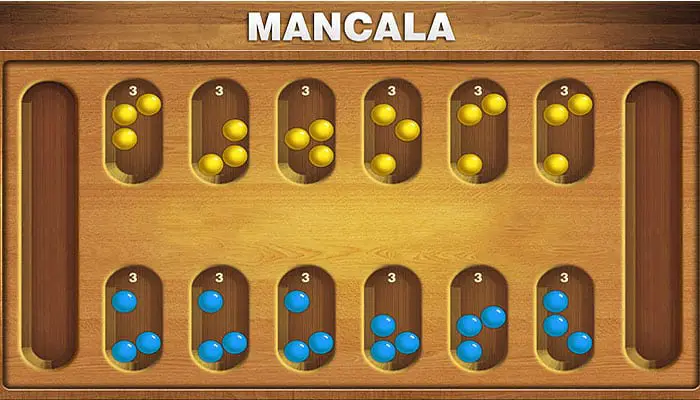
If the last stone is placed in an empty pit on the player's side, he places that stone and the seeds in the opposite pit in his mancala.If the empty pit is on the opponent's side, nothing happens.This continues back and forth until the last stone is dropped into an empty pit.If the last stone is placed in a pit with other seeds, the player picks up all the seeds and drops them in the opposite direction.Players may choose to drop seeds in either direction.Start the game with six seeds in each small pit.The more pits, the more challenging the game will be so beginners may do best with a smaller board with six pits in each row.A typical Giuthi board may also have more pits on it, with between five and ten on each side.This game requires more seeds than other variations, and you may wish to use smaller objects to make sure they will fit in the pits.

Giuthi is a version of mancala that is played in Kenya and the word means "to place" in Kenyan. If both players are unable to make a move, they may split the remaining seeds or ignore them in the final count.
:max_bytes(150000):strip_icc()/how-to-win-at-mancala-basic-strategy-411832-FINAL-5bfd5a7d46e0fb0051f3f2f3.png)
The other player keeps his remaining seeds.
The game ends when one player's pits are empty and the other player can't make a move that would drop seeds in the empty pits. If the seeds from a pit allow for more than one lap around the board, skip the pit from which they were taken. The same rule applies to all previous pits on the opponent's side until the original player either comes to a pit with more or less seeds or arrives at his board. If the second-to-last pit has two or three seeds, those seeds are taken too. If there is any other number, the seeds remain in the pit. When the last seed is dropped in an opponent's pit, the player may take the seeds if there are two or three total. Start the game with four seeds in each pit. The rules are similar to the basic mancala rules with these variations: The player with the higher number of points wins the game.Oware is a commonly played version that is popular in West Africa and the Caribbean. When it happens, all beads which remains at the opponent's holes are added to the opponent's score. The game is finished if one of the players cannot make a legal move - there are no beads in his row. The next picture shows a capturing move - before and after:: If the last bead (of the current move) is placed to an empty hole (on the player's side), all beads at the same column of the opposite row are captured and placed to the player's home area. The next picture displays such a move - the first hole selection (the one which contains a green bead now) placed the last bead to the home area, so the player emptied the second hole (the one which is empty now): If the last bead (of the current move) is placed to the home area, the player continues to select another non-empty hole. The following picture shows an example of the first move - the player has removed all 4 beads from the marked hole, placed 1 bead to the 4 next fields (including the home area) and received 1 point: The player cannot place the beads to the opponent's home area. The player's home area (at the right side of the board from his point of view) is used in this bead separation as well and when a bead is placed there, the player gets 1 point. 
This action will take all beads from the selected hole and place them one by one to the next holes, counter clockwise. The player, who is to make a move, clicks on a hole (from the row which is closer to him) containing at least one bead. The game object is to get more points than the opponent by moving beads to the home area or capturing the opponent's ones. The next picture shows the initial position: The game is played on the 6 x 2 board (with two home areas at the board sides) and every hole contains 4 beads at the start.

However, the BrainKing's version is called Mancala for a simplicity. Mancala is actually a family of similar games, not just a specific game name.



:max_bytes(150000):strip_icc()/how-to-win-at-mancala-basic-strategy-411832-FINAL-5bfd5a7d46e0fb0051f3f2f3.png)




 0 kommentar(er)
0 kommentar(er)
